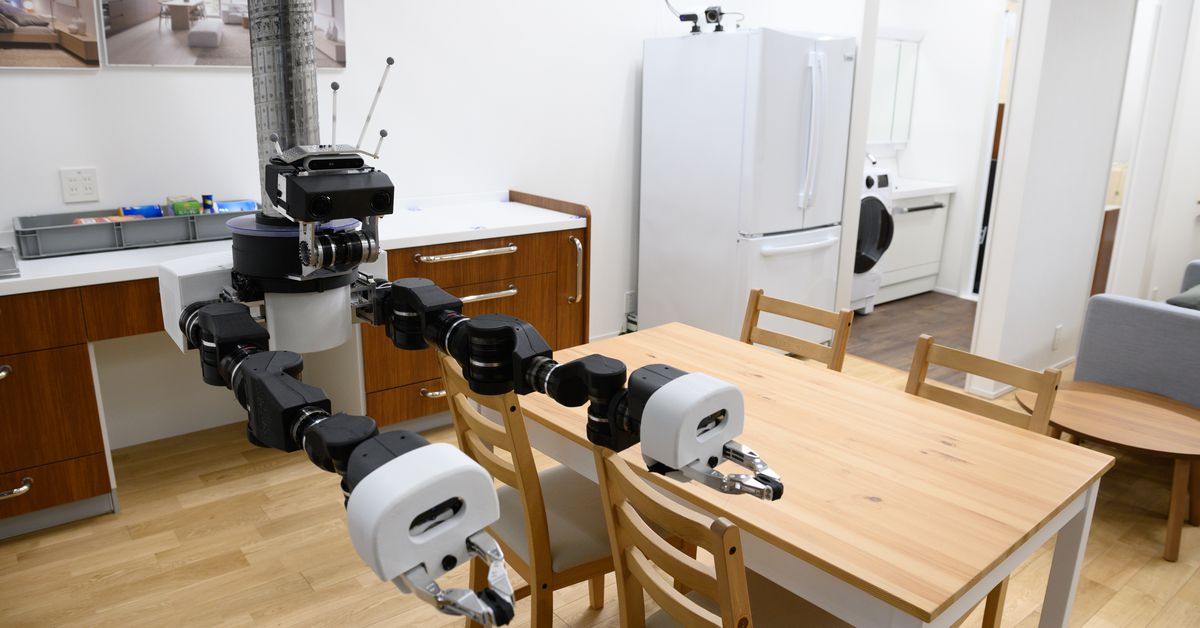
A Carnegie Mellon team recently developed software that teaches robots how to learn new tasks, simply by observing humans doing the same tasks first. These robots have figured out how to open cabinets and remove trash bags without any direct instructions and could eventually learn how to complete chores just by watching YouTube videos. While the research is still preliminary, the software offers a glimpse into an uncertain future where robots are more helpful companions around the house.
For years, tech companies have teased a Jetsons-like future where robots clean our counters and mop the floor. Dyson, a company known for its fancy vacuums, revealed in May that it’s been building out a team to develop robots that can sort through dishes and even clean under couch cushions. Samsung suggested last year that we may soon have robot butlers zooming around the house, picking up dirty towels and pouring glasses of wine. Still, aside from smart speakers and semi-automated appliances, home robots are hardly common in the average household right now. But the future of these devices — and what they might ultimately do in our homes — will likely take shape in the next few years.
Advancements in AI have also fueled a whole other class of robots that can complete more specialized tasks, like clearing out snow, emptying cat litter, and cleaning grills and pools. There are also social robots, which are designed to simulate companionship, set reminders, and anticipate the schedules of the people using them — an application that’s particularly helpful for seniors. One such device, called ElliQ, recently went on sale in the US, and New York State already has plans to distribute 800 of these robots among the state’s older residents. One ElliQ robot costs $250, and then another $30 a month for an annual subscription to the robot’s content.
Most of these robots can’t accomplish much beyond what they’re explicitly designed to do, which can make the idea of spending hundreds, or even thousands, of dollars on one of these devices unappealing. This is the problem that the Carnegie Mellon researchers aimed to solve by designing their software, which is called WHIRL, or In-the-Wild Human Imitating Robot Learning. WHIRL can be installed into any robot, and adapts based on the physical capabilities of that particular device. After studying what the human within its home is doing, the robot tries to teach itself how to complete the same task, using whatever mechanical limbs it might have.
[embedded content]
“Every task is unique, and we as humans can do all those tasks,” Pathak, the Carnegie Mellon professor, told Recode. “Our robots currently are not capable of that. They’re the opposite. They can only do one task in one environment.”
The most promising advances in AI-powered robotics have yet to make it to market. And many of the robots consumers can buy are still struggling with basic problems: Amazon’s Astro robot can move around on even surfaces but can’t climb stairs, and sometimes struggles with navigation problems. Most home robots similarly lack the dexterity needed to grab and hold objects, which is a prerequisite for most chores. There’s also the risk of the robot making a mess instead of cleaning one up. iRobot famously had to update its Roomba software after pet owners complained that the vacuums couldn’t spot dog poop on the floor and would run over it, smearing it all over.
Home robots could get a boost as smart home tech takes off. Apple, Amazon, Samsung, and Google are already collaborating on Matter, a common platform for smart home devices made by different companies. The hope is that tech could eventually direct a fleet of our devices, which, collectively, could monitor security cameras, adjust the thermostat, and turn lights on and off. Indeed, this idea that the entire home could become more autonomous exists alongside the dream of a robo-butler.
“You can almost imagine a Rosey The Robot scenario, where you have this one super-complex robot that can do everything. It can vacuum your floor, it can fold your laundry and do the dishes,” said Chris Jones, the chief technology officer at iRobot, the company that makes the Roomba robovac. “An alternative vision is actually more akin to the bridge in Star Trek. It’s kind of an ambient intelligence that stitches together many devices in the home that collectively form, essentially, one big distributed robot.”
Still, it’s not clear yet how home robots will ultimately fit into that picture, since many still aren’t that sophisticated, and feel more like a gimmick than an actually helpful hand.
“With the success of things like Google and Alexa, which has pushed artificial intelligence into homes, maybe that’s widening the gates for more robots. But I think robots still stumble around certain physical things,” said Scott Midson, a University of Manchester liberal arts professor. “They’ve got all this success in talking to us, and learning our quirks and our actions, but robots are still, for the most part, learning the quirks of our surroundings.”
Hopefully, home robots do get better, and our apartments and houses start looking a little more like the Jetsons. After all, if the smart home does become a reality for most people, a constellation of home robots, overseen by smart home technology, could take on all sorts of tasks we’d rather not do. This would give us humans a lot more time to do things that we love, or at least, things we like far better than taking out the trash.
This story was first published in the Recode newsletter. Sign up here so you don’t miss the next one!






